A Crown Without a King: The Fascinating Story Behind the 1653 Commonwealth Silver Crown

The 1653 Commonwealth Crown is not just a coin—it's a time capsule from England’s only experiment in republican government. Struck during one of the most turbulent chapters in British history, this large silver piece tells a story of power, ideology, and exceptional rarity. Whether you are a seasoned collector, a history lover, or a savvy investor seeking tangible assets, this coin represents a unique opportunity.
1. The Coin That Dared to Be Different
In 1653, England was without a king. After the execution of Charles I in 1649, the monarchy was abolished and replaced by the Commonwealth—a short-lived republic led by Oliver Cromwell. In this radical new era, even the national coinage changed. Gone were the crowned monarchs and Latin mottos. In their place, the Commonwealth coinage proudly displayed English shields, English inscriptions, and a religious motto: “GOD WITH US.”
The 1653 Crown, minted in London and weighing approximately 30 grams, carries a simple yet powerful design. On the obverse, a Saint George’s Cross shield is encircled by laurel and palm branches—symbols of victory and peace. The reverse features paired shields of England and Ireland with the date and value (“V” for 5 shillings), surrounded by the bold declaration “GOD WITH US.”
This was more than a coin. It was political propaganda in silver—a revolutionary government’s manifesto struck into metal.
2. Why This Coin Matters Today
The Commonwealth Crown stands apart in numismatics for several reasons:
-
Historical significance: It was minted during England's only republican regime. Few other coins so directly reflect political upheaval.
-
Design rarity: The use of English rather than Latin, and the absence of any monarch’s portrait, was unprecedented at the time.
-
Short-lived issue: These coins were produced only from 1649 to 1653, and most were melted down after the monarchy was restored in 1660.
-
Collector rarity: Few examples survive today, and even fewer are in high grades.
One remarkable specimen, graded MS62 by PCGS, recently sold at a Stack’s Bowers auction for over ¥2,450,000 (approx. $17,000). For context, this is one of the highest grades known for this type, making it a near-untouchable acquisition for collectors.
3. A Crown Fit for an Investor
Rare coins like the 1653 Crown have become increasingly desirable in the investment world. As tangible assets, they offer:
-
Historical value: A finite number of examples means they are immune to inflation or mass production.
-
Global appeal: British coins, especially from iconic periods like the Commonwealth, are recognized and traded worldwide.
-
Market momentum: With renewed interest in early English coins and limited supply, prices are steadily climbing.
Compared to other Commonwealth issues—such as the Half Crown or Cromwell’s portrait coins—the 1653 Crown occupies a special niche. It is large, symbolically rich, and has the visual gravitas of a historical relic.
Final Thoughts: Holding History in Your Hands
There’s something deeply compelling about the 1653 Commonwealth Crown. It’s not just the silver or the striking design—it’s the sense of holding a fragment of defiant history. In a world where kings were tradition, this was the coin of a republic, minted in a moment of revolutionary hope and fierce religious conviction.
For collectors, it’s a treasure. For investors, it’s a hedge and a statement. For historians, it’s a reminder that even coins can speak loudly of freedom, ideology, and change.
Whether you’re building a collection or looking to diversify your portfolio with meaningful assets, the 1653 Commonwealth Crown is more than a coin—it’s a legacy.
